Annedroids Appisodes and the Potential of Interactive Kids TV
 As Meagan Rothschild noted in a recent Antenna post, the growth and diversity of screen media for children suggests the need to look beyond the issue of screen time to how media can lead to different kinds of inactivity and interaction. While Rothschild’s example largely points to the activity of children inspired by but away from screen media, I would like to consider how shifts in media consumption that have seen children consuming media (including video) on internet enabled and mobile devices like phones and tablets have fostered burgeoning changes in media with the potential to alter the way we think of interactivity, media, and its potential for education.
As Meagan Rothschild noted in a recent Antenna post, the growth and diversity of screen media for children suggests the need to look beyond the issue of screen time to how media can lead to different kinds of inactivity and interaction. While Rothschild’s example largely points to the activity of children inspired by but away from screen media, I would like to consider how shifts in media consumption that have seen children consuming media (including video) on internet enabled and mobile devices like phones and tablets have fostered burgeoning changes in media with the potential to alter the way we think of interactivity, media, and its potential for education.
In particular, I am interested in the growth of “Appisodes”: versions of television episodes with embedded games and interactive components that allow viewer/players to interact directly with the narrative, often through mini-games or other interactive components that punctuate the episode and are required to move the story forward. Introduced with minimal fanfare, Appisodes (which I have referred to as “Merged Screen” experiences) have recently been made available through outlets like the Itunes store or Amazon. The first few appisode apps released had a number of factors in common. Disney Jr. Appisodes, (which I have written about elsewhere), Dora the Explorer Appisodes, and VeggieTale Appisodes were all extensions of broadcast television animated series targeted at pre-schoolers. However, the most recent addition, Annedroid Appisodes produced by Amazon, breaks from this formula and points to some of the broader potential—and limitations—in this new format for children’s media.
 Annedroids is a part of Amazon’s effort to compete with Netflix and Hulu through Amazon Prime and the creation of original programing. Annedroids is a half-hour live action series targeted at elementary school-aged children, and follows the exploits of a young girl Anne who designs, builds, and programs large, complex, and personality-filled robots and conducts scientific experiments and solves problems with the help of her two friends Nick and Shania. Made with a combination of live-action and CGI techniques, the series incorporates a large number of scientific concepts, using the robots and CGI elements to depict dangerous and dramatic scientific experiments while still using child actors that are relatable, realistic, and differ dramatically from the glitter and glam of many Disney stars. In addition to these science-centered storylines, the main character is a young girl who has an extensive knowledge of science and a penchant for building, coding, and engineering, presenting a strong role-model for young girls.
Annedroids is a part of Amazon’s effort to compete with Netflix and Hulu through Amazon Prime and the creation of original programing. Annedroids is a half-hour live action series targeted at elementary school-aged children, and follows the exploits of a young girl Anne who designs, builds, and programs large, complex, and personality-filled robots and conducts scientific experiments and solves problems with the help of her two friends Nick and Shania. Made with a combination of live-action and CGI techniques, the series incorporates a large number of scientific concepts, using the robots and CGI elements to depict dangerous and dramatic scientific experiments while still using child actors that are relatable, realistic, and differ dramatically from the glitter and glam of many Disney stars. In addition to these science-centered storylines, the main character is a young girl who has an extensive knowledge of science and a penchant for building, coding, and engineering, presenting a strong role-model for young girls.
Annedroids, therefore, seems like the perfect fit for conversion into the appisode format. The series’ focus provides the opportunity for simple coding-based mini-games or games and activities that teach scientific principles. Given the older target audience of Anendroids, one might imagine that there would be a higher level of educational content in their Appisodes. However, in practice Annedroids Appisodes only show hints of this potential. Of the first two episodes released, each included only three interactive elements/games, only one of which (in each episode) had a clear educational component. Both of these games are based around the idea of completing increasingly complex circuits. Some other games included minor educational components (like the inclusion of weather data or different kinds of animal footprints), but most were based around simple movements—chasing or running from something—or finding the right spot where something was hidden.
By looking at Annedroids Appisodes, a number of challenges, limitations, and potentialities of the form can be seen. While interactive elements can be easily incorporated into a series like Dora the Explorer or Doc McStuffins because they are animated, converting live-action content into animated games in a way that appears seamless and preserves consistent quality is much harder. This is a challenge that must be resolved in order to make Appisodes a realistic option for a broader variety of content. How to incorporate interactive content in a way that authentically adds value and to the episode and is fun and engaging is another challenge, one that the distinctions between the Annedroids Appisodes and previous iterations places further into context.
 Amazon’s stake in selling not only their content but their platforms to consumers makes their children’s content a strong site for considering the potential of appisodes for both creative-storytelling (lauded by Annedroids creator J.J. Johnson) and interactivity. With initiatives like Kindle Free Time, part of Amazon’s pitch to families is its ability to curate media content so children only have access to “age-appropriate” media and can be limited in terms of time spent on non-educational content. While series have only just begun exploring how children’s established media habits—including repetitive viewing and viewing on mobile devices—and access to new devices can allow for new forms of storytelling/media interaction, the themes and limited interactive elements of Annedroid Appisodes is an important case study in considering the limits places on such efforts.
Amazon’s stake in selling not only their content but their platforms to consumers makes their children’s content a strong site for considering the potential of appisodes for both creative-storytelling (lauded by Annedroids creator J.J. Johnson) and interactivity. With initiatives like Kindle Free Time, part of Amazon’s pitch to families is its ability to curate media content so children only have access to “age-appropriate” media and can be limited in terms of time spent on non-educational content. While series have only just begun exploring how children’s established media habits—including repetitive viewing and viewing on mobile devices—and access to new devices can allow for new forms of storytelling/media interaction, the themes and limited interactive elements of Annedroid Appisodes is an important case study in considering the limits places on such efforts.
Media is a significant part of many children’s lives, and how to encourage children to interact with this media in creative, playful, and even educational way represents an important avenue for parents and scholars to consider. Appisodes represent the possibility of incorporating the kinds of interactive learning studied and promoted in other media such as video games into children’s consumption of television content. For distributors like Amazon who are presenting their platform as a better alternative for many parents, explicitly activating the educational content potential of Appisodes can help to differentiate them and garner positive attention as the educational content of Annedroids itself has done. As a scholar and an aunt of two young girls, considering how a platform that is only beginning to take shape might be developed in a way that increases the play, interactivity, and educational potential of media presents an important opportunity to look at the growth of new media as an opportunity to develop the best aspects of media designed for children, not as a threat to children it is sometimes framed. As a fledgling format, Appisodes may have not reached this potential, but as the format grows parents, educators, and children’s media scholars will have the opportunity to explore what it does well, what it struggles with, and how we can advocate for the value of merging video and interactive content in children’s media’s future.


